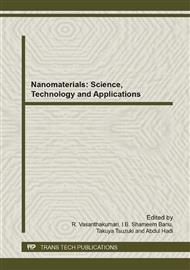p.103
p.108
p.114
p.118
p.123
p.128
p.134
p.140
p.145
Investigation of Optical Properties of ZnO/MnO2, ZnO/TiO2 and ZnO/MnO2/TiO2 Nanocomposites
Abstract:
ZnO nanocomposites such as (ZnO) 0.8(MnO2)0.2, (ZnO) 0.8(TiO2)0.2and (ZnO) 0.8 (MnO2)0.1(TiO2)0.1 were prepared by solid state reaction method at room temperature. The structural analysis was carried out with help of powder XRD to confirm the formation of the composites. The morphological properties and presence of elemental compositions were analyzed with scanning electron microscope and energy dispersive analysis spectroscopy respectively. Optical properties were studied with UV visible spectrophotometer. From the transmittance spectrum, it is concluded that the synthesized composite materials have the transmittance in the range of 80 to 95% in the visible region. The calculated optical band gap values for pure ZnO is 3.16 eV and the values are 3.7eV, 5.27eV and 4.46eV for the composites ZnO/MnO2, ZnO/TiO2 and ZnO/MnO2/TiO2, respectively. The study has found that the ZnO/MnO2, ZnO/TiO2 and ZnO/MnO2/TiO2 composites have very large energy gap as that of insulator.
Info:
Periodical:
Pages:
123-127
Citation:
Online since:
June 2014
Authors:
Keywords:
Price:
Сopyright:
© 2014 Trans Tech Publications Ltd. All Rights Reserved
Share:
Citation:


